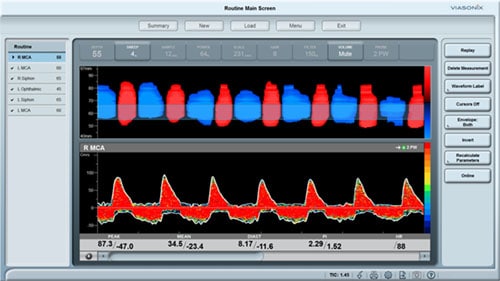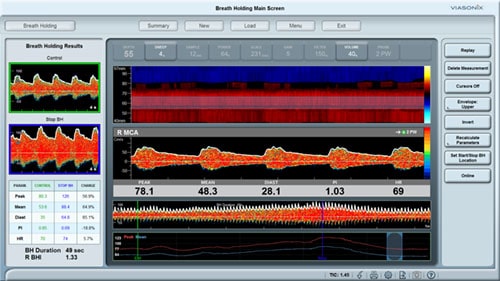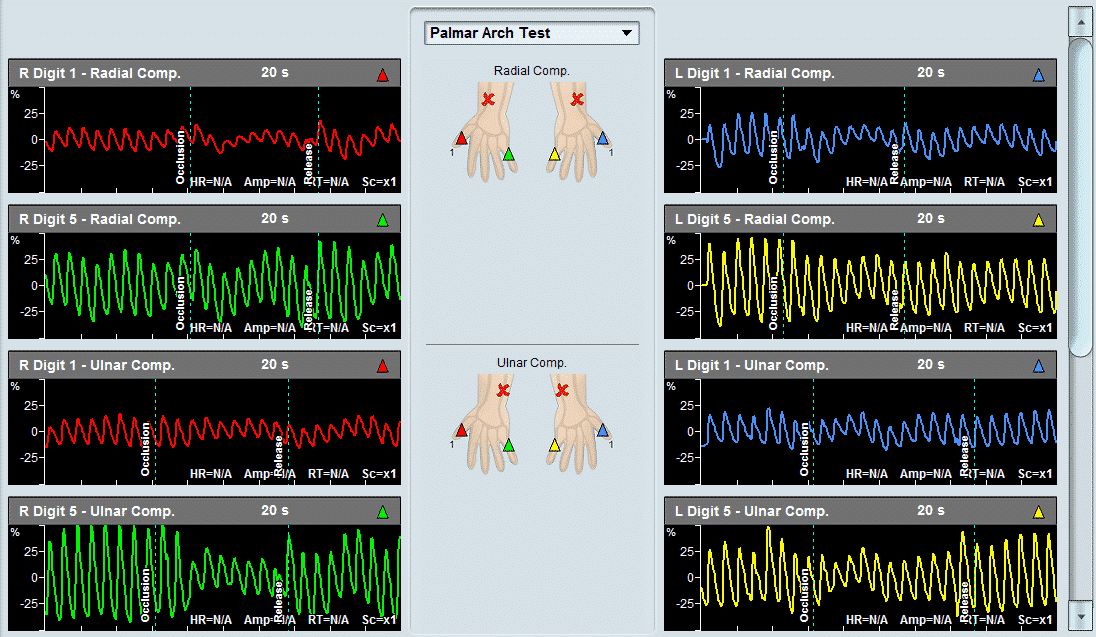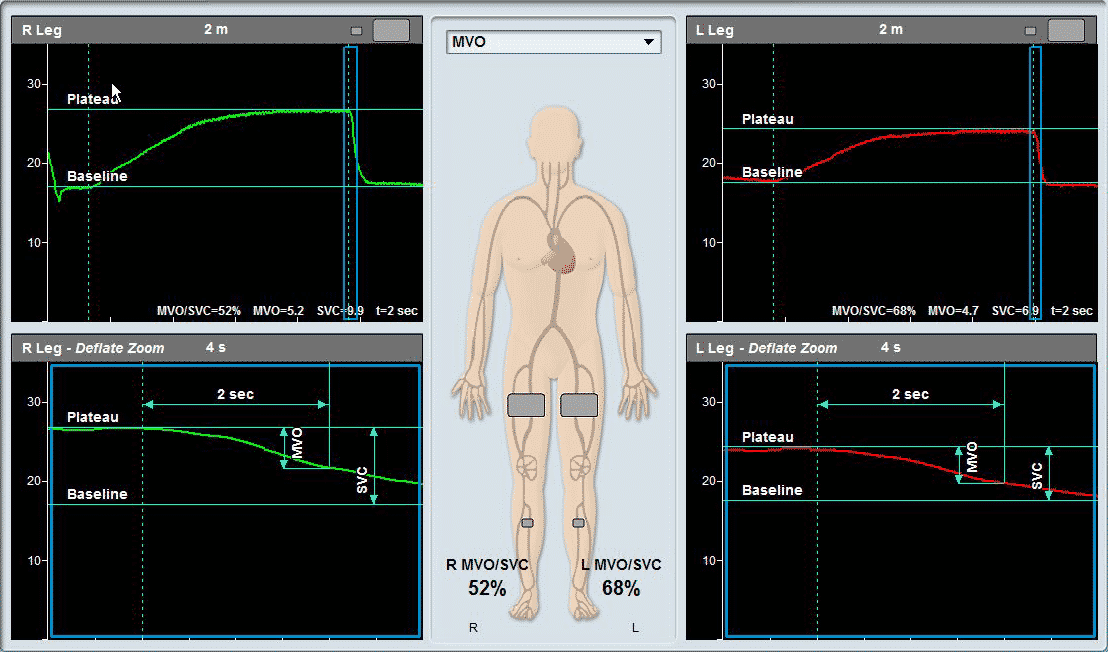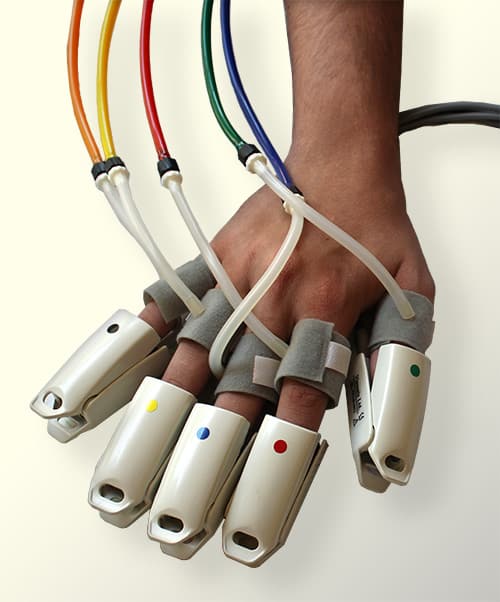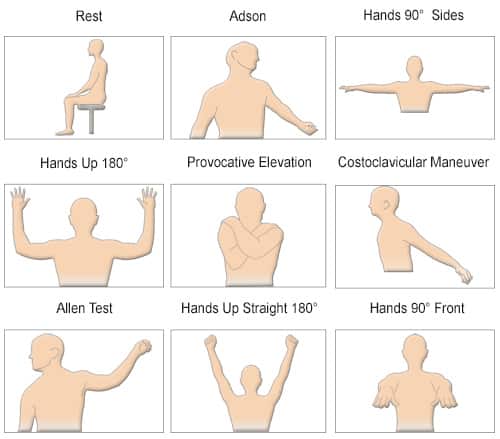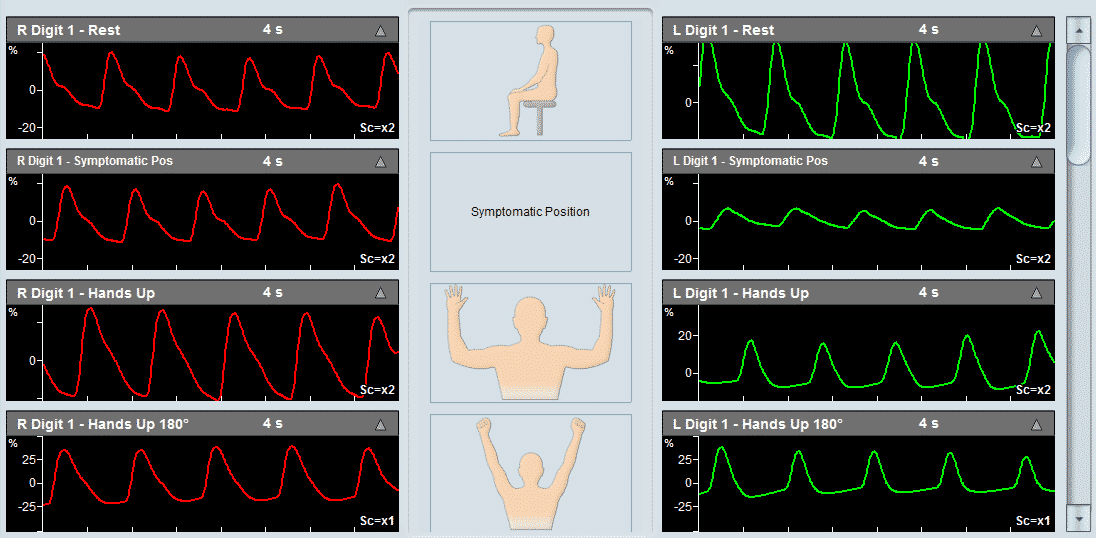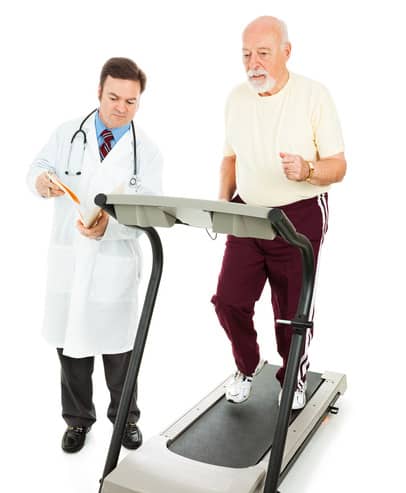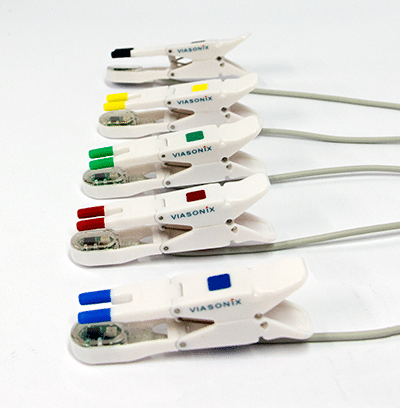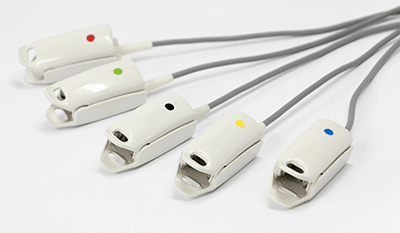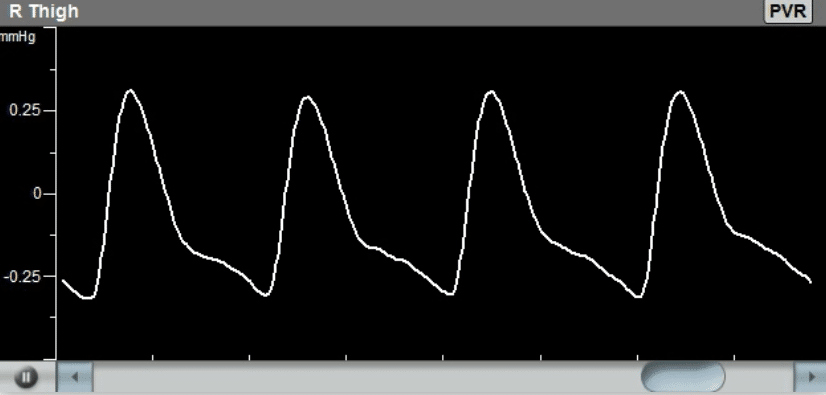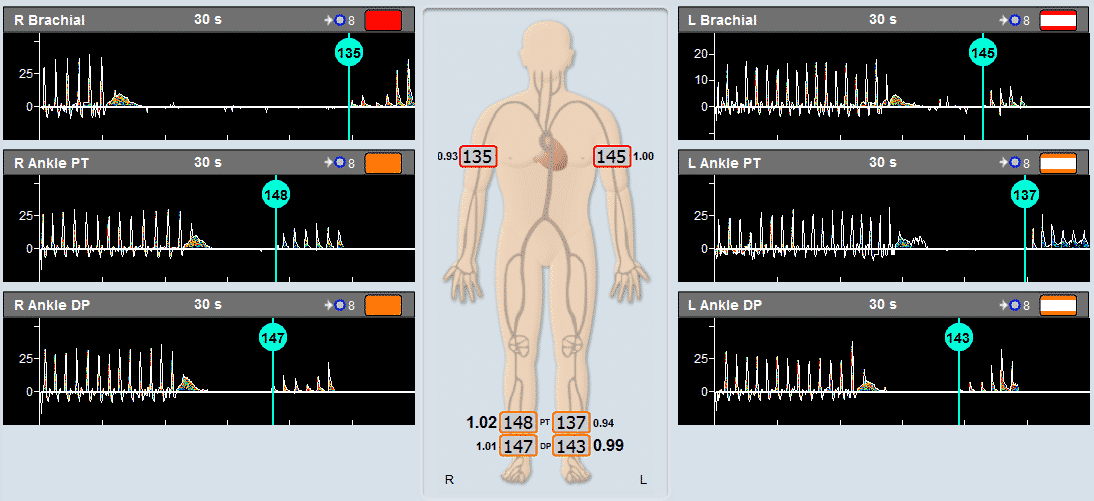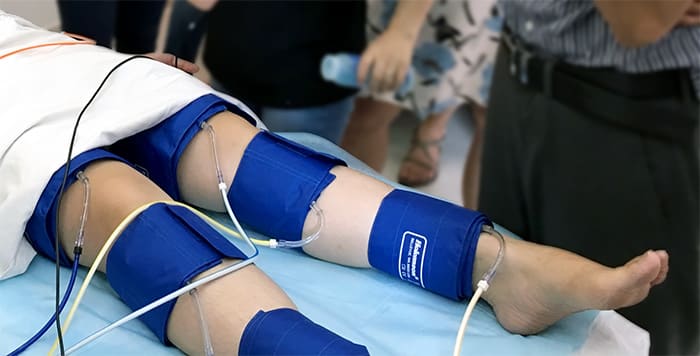What is Ankle Brachial Index?
The Ankle Brachial Index is a standard and common method of physiologic assessment of vascular pathology in the lower limbs in a fast and simple manner.
Systolic pressures are measured in each of the right and left brachials, as well as at the level of the right and left ankles. Ankle Brachial Index, or ABI, is determined as the ratio between the higher brachial systolic pressure and each of the ankle pressures. Thus, a separate ABI value is obtained for the Right side and the Left sides.
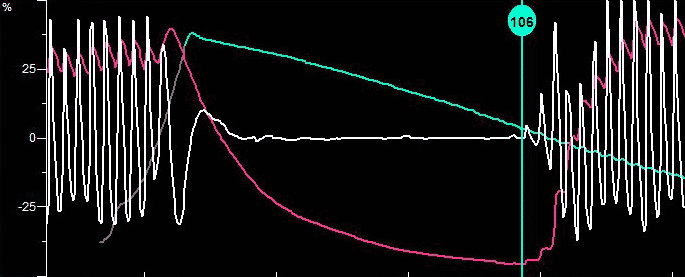

How to Measure Ankle Brachial Index
Measuring the Systolic blood pressure with an ABI machine is simple. Once a pressure cuff is wrapped around the measured site, a distal Doppler or Photoplethysmograph (PPG) waveform is obtained. The cuff is then inflated until the distal signal disappears as a result of the total occlusion. The pressure cuff is then deflated in a controlled manner, and the pressure at which the distal signal re-appears is determined as the systolic pressure.
Using Doppler to measure the distal waveform is the traditional and clinically accepted method, although PPG sensors are also used in specific conditions or locations.
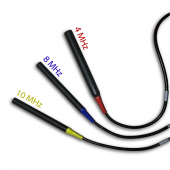
Doppler Probes
Gold Standard ABI Measurement Method
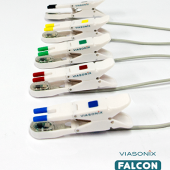
PPG Sensors
Secondary Method of ABI Assessment

Inflatable Cuffs
High quality available in a variety of sizes
Using the Falcon for ABI measurements
The Falcon is considered to be the best ankle brachial index machine as it allows very simple and fast diagnosis of ABI. Simply place 4 color-coded pressure cuffs on each of the right/left brachial and ankle sites, select the ABI protocol, and you are ready to go. The ABI test can be completed in just a couple of minutes.
The Falcon is also known as a peripheral vascular diagnosis system as it allows you to select from a wide variety of Doppler probes and PPG sensors for best outcome. All Doppler probes, PPG sensors and pressure tubes are color coded to allow optimal user interface and correlation with the dedicated software. The target inflation pressure, as well as the deflate rate and various other parameters can be customized by the user for optimal measurements.
Numerous other features and options of the Falcon system, such as automatic cuff inflation once a signal is identified, or simultaneous measurements, display of contralateral results, and many more options, are designed to simplify the use of the Falcon ABI physiologic system in a fast and efficient way.
Once the distal Doppler or PPG waveform reappears during the deflation phase of the pressure cuff, the measurement can be stopped, and the Falcon places a cursor to mark a potential systolic pressure. The user may move the cursor to a different location, and the systolic pressure is changed accordingly. R/L ABI are calculated automatically by the Falcon and presented clearly on the screen and in the report layout.
Example of an ABI test performed on a patient using Viasonix Falcon/PRO ABI Doppler machine. The sensor used in this case is 8 MHz Doppler probe.
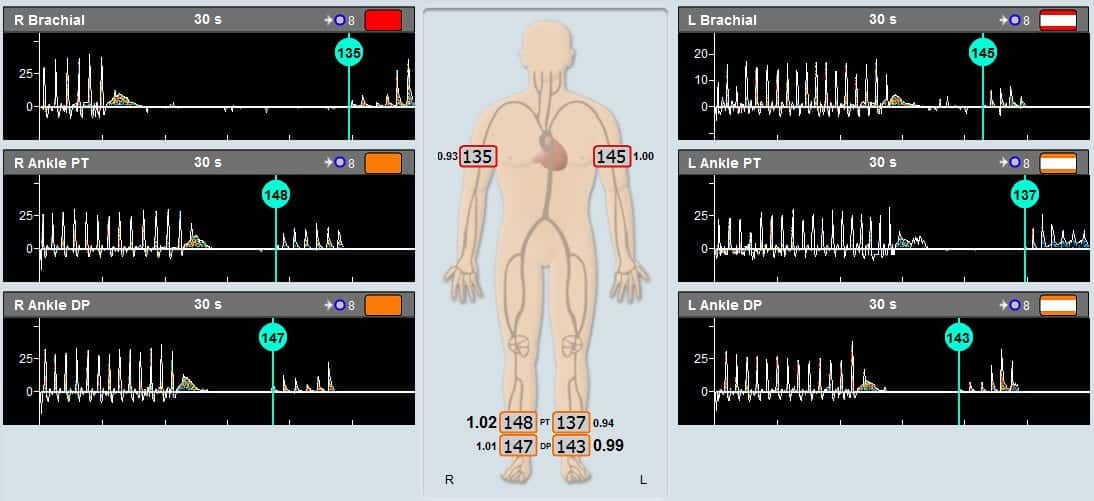
Expected Results of ABI Test
According to many international guidelines, such as the AHA, ABI is diagnosed and evaluated as follows:
| Range | Common Diagnosis |
|---|---|
| ABI ≥ 1.4 | Non compressible arteries |
| 1 ≤ ABI < 1.4 | Normal |
| 0.9 ≤ ABI < 1 | Borderline |
| ABI ≤ 0.9 | Abnormal |
An ABI ratio of around 1 is considered normal, while lower values indicate various levels of significant peripheral arterial disease (PAD) and higher ABI values represent incompressible arteries which are typically associated with higher vascular stiffness.
Selected Literature
Overview of Peripheral Arterial Disease of the Lower Extremity, Ali F. AbuRahma and John E. Campbell, Noninvasive Vascular Diagnosis, A.F. AbuRahma (ed.), Springer International Publishing AG 2017, Ch 21, pp 291-318
2016 AHA/ACC Guideline on the Management of Patients With Lower Extremity Peripheral Artery Disease; A Report of the American College of Cardiology/American Heart Association Task Force on Clinical Practice Guidelines; Journal of the American College of Cardiology, Vol. 69, No. 11, 2017
Peripheral vascular disease assessment in the lower limb: a review of current and emerging non‑invasive diagnostic methods, Shabani Varaki et al, BioMed Eng OnLine (2018) 17:61
2017 ESC Guidelines on the Diagnosis and Treatment of Peripheral Arterial Diseases, in collaboration with the European Society for Vascular Surgery (ESVS), Victor Aboyans et al., European Heart Journal (2017) 00, 1–60
The Ability of the Toe-Brachial Index to Predict the Outcome of Treadmill Exercise Testing in Patients with a Normal Resting Ankle-Brachial Index, Christian Høyer et al, Annals of Vascular Surgery, Volume 64, April 2020, Pages 263-269
Association of cardiovascular autonomic dysfunction with peripheral arterial stiffness in patients with type 1 diabetes, Lía Nattero-Chávez et al, The Journal of Clinical Endocrinology & Metabolism
Measurement and Interpretation of the Ankle-Brachial Index, Victor Aboyans et al, Circulation. 2012;126:2890–2909
The effect of percutaneous transluminal angioplasty of superficial femoral artery on pulse wave features, Mikko Peltokangas et al, Computers in Biology and Medicine 96 (2018) 274–282
Disclaimer of Information & Content
The content of Viasonix Ltd. website is for information only, not advice or guarantee of outcome. Information is gathered and shared from reputable sources; however, Viasonix Ltd. Management is not responsible for errors or omissions in reporting or explanation. No individuals, including those under our active care, should use the information, resources or tools contained within this self-diagnosis or self-treat any health-related condition. Viasonix Ltd. Management gives no assurance or warranty regarding the accuracy, timeliness or applicability or the content.

